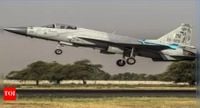NEW DELHI: Tensions between India and Pakistan have escalated dramatically following a series of military confrontations, culminating in India's air defense systems shooting down two Pakistani fighter jets on the evening of May 8, 2025. This action, reported by news channels NDTV and India Today, was part of India's ongoing counterterrorism efforts under 'Operation Sindoor'.
According to multiple sources, including ANI, one of the downed aircraft was a Pakistani Air Force jet shot down in the Pathankot sector. This retaliatory move by India came in response to coordinated drone attacks launched by Pakistan across various locations along the India-Pakistan border.
As tensions mounted, the Pakistan army attempted to breach the Line of Control (LoC) and International Borders on the same night. However, Indian forces successfully intercepted and shot down over 50 swarm drones, thwarting the Pakistani incursion. The Indian military's decisive actions were seen as a direct response to a recent terror attack in Pahalgam, which resulted in the deaths of 26 individuals, including a Nepalese man and a local pony ride operator.
In retaliation for the Pahalgam attack, India had launched 'Operation Sindoor' on May 7, targeting nine terrorist infrastructure sites linked to groups such as Lashkar-e-Taiba and Jaish-e-Mohammed. The operation involved airstrikes from Rafale jets armed with SCALP cruise missiles and HAMMER precision-guided munitions, striking deep into Pakistan and Pakistan-occupied Kashmir.
Amidst this backdrop, Pakistan has claimed, without providing evidence, that its military shot down five Indian fighter jets, including three Rafales, during the confrontations. Pakistani Foreign Minister Ishaq Dar made these assertions in the National Assembly, but Indian military experts have dismissed these claims as disinformation, noting the lack of supporting evidence such as cockpit recordings or radar data.
Reports from U.S. officials have further complicated the narrative. They indicated that a Chinese-origin Pakistani combat aircraft, possibly the J-10C, was responsible for downing at least two Indian warplanes, including a Rafale. However, these claims remain unverified and have been met with skepticism.
In response to the ongoing conflict, the Indian government has issued warnings regarding the spread of misinformation. Pakistani social media has circulated false narratives, including claims that an Indian fighter jet was shot down and its pilot captured in Pakistan-Occupied Kashmir. The government clarified that the photo used to support this claim was of a Sukhoi jet that crashed in Maharashtra in 2014.
The Press Information Bureau (PIB) of India has actively fact-checked numerous viral posts, debunking claims about ATMs being shut down and other fabricated stories. The PIB emphasized the importance of verifying information amidst the rising tide of misinformation from Pakistan, particularly following the recent military escalations.
As the situation continues to unfold, both nations are bracing for further military engagements. The Pakistan Air Force (PAF) has been bolstering its capabilities with the acquisition of advanced Chinese aircraft, including the J-10C, which is designed to counter India's growing military prowess. The J-10C, a 4.5-generation multirole fighter, is equipped with advanced technology and weapons systems, aiming to enhance Pakistan's aerial capabilities significantly.
In contrast, India's Rafale jets, which have been operational since 2020, are equipped with the latest technology and have proven combat experience. The Rafale's advanced electronic warfare suite and beyond-visual-range (BVR) missile capabilities position it as a formidable adversary in the region.
As both countries prepare for potential escalations, the question remains: will diplomacy prevail, or will military confrontations continue to dominate the landscape? The stakes are high as both nations navigate this precarious situation, with the potential for further loss of life and destabilization in the region.
In light of these developments, experts are closely monitoring the situation, assessing the implications for regional security and the broader geopolitical landscape. The need for dialogue and de-escalation has never been more critical as both India and Pakistan grapple with the consequences of their military strategies and the ongoing threat of terrorism.





